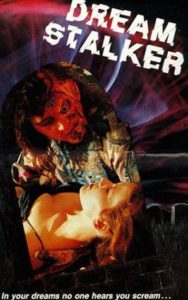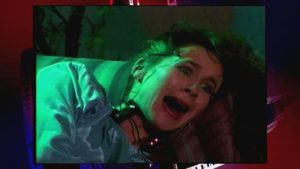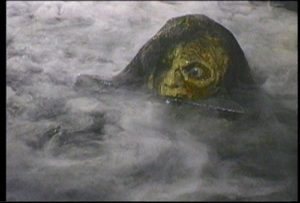DREAM STALKER is a shot-on-video comedy-horror film from 1991 available in a re-release April 11, 2017 by Severin Films. In the film, Mark Dias plays Ricky, who has been described as a “dirt-bike Freddy Krueger,” a possessive and murderous ex-boyfriend manifested in telekinetic dreams by the grieving girlfriend, Brittany, he left behind. DAILY GRINDHOUSE got a chance to talk to Mark Dias about his role in the film and the enduring legacy of DREAM STALKER.

DAILY GRINDHOUSE: What was attractive to you about this role?
MARK DIAS: The first thing is I was a young kid and it was my first thing. I was just out of college and doing theater and student films. I did something with a company called Learning Curve out of Sacramento, which wanted a million-dollar budget, but Learning Curve did something more like an after-school special. These were local filmmakers looking to do it for around $100,000 total. They wanted to do a comedy they could sell. I was just out of college, and I wasn’t going to L.A. I read the script–the original script was called KINETIC NIGHTMARE. It wasn’t a zombie brought to life, it was a telekinetic manifestation of a boyfriend who died. He would kill anybody who caused any problems–Ricky would get in the way. It was fun and interesting early on. We weren’t making THE EXORCIST, more something like A NIGHTMARE ON ELM STREET or FRIDAY THE 13TH.
DG: How did you prepare for this role?
MD: I was pragmatic. If you’re doing a historical drama on Lincoln, you go method. When you’re doing a fun movie, you just learn your lines, rehearse, and show up on time. Tons of footage wasn’t useable because the sound was so bad. With the technology we had to deal with, HD video would have looked and sounded a lot better. We had a scene where three of four of these guys were hanging upside down, and I felt bad for them because it only provided footage for a brief moment. You’re just making it up as you go along, these kind of things happen in a low-budget movie. If everything had been released in a viewable quality, it would have been good for Chiller or a late-night station.
DG: How did the shot-on-video aspect of the film influence your acting?
MD: Not at all. I’ve done network TV and movies, serious as it needs to be, where when it’s time to go you focus. I had only done one film and a couple commercials before this, literally nothing. You just have to be there and have that energy. Most of the shoot was on location out in the woods, most of the night, so we would sleep late at night and get up mid-morning. One of my biggest frustrations is things didn’t go as smooth as possible. I’d shoot a scene, and the makeup would dry out or crack, and then they’d have to re-apply it. The lighting was weird too. It looked better on location, most of it actually looked better at night.

DG: Speaking of the makeup, how did wearing that makeup influence your acting?
MD: A costume can really help you. It might have been cheesy, but compared to the CGI of the time it looks good. I was flashing that mullet with my own hair. Makeup is like your armor–a nice threatening presence during the yelling action scenes–but when it started to dry up or crack I couldn’t move my mouth as much.
DG: How did the ’80s genre aspect of the film influence your acting?
MD: You can do a little comedy, a little T & A, a little romance. I mean, how many NIGHTMARE ON ELM STREETS and FRIDAY THE 13THS can you make, and then you can wink at the genre with movies like SAW. It was also naive and fun, an original idea a la CARRIE–Carrie doesn’t realize she’s killing everyone. Then there was the idea with the music box, that it might be influencing your dreams. And, like NIGHTMARE, it can kill you when you’re asleep. The goal of these movies was pure entertainment, no big message. But then parts of the script were lost and it didn’t make as much sense.
DG: How did you transition from the loving, devoted Ricky to the dead and possessive one?
MD: Well, a funny background story on that—my favorite and least favorite whole section is where live Ricky was—it was supposed to be a montage of an idyllic couple falling in love. Then Ricky dies and the movie starts. Because we lost a lot of footage, the 30-second montage became a five-minute portion of the movie. I didn’t think the live Ricky was going to be a part of the movie–your normal douchey, possessive boyfriend. But the movie’s more about her psychological problems–Ricky seemed to be a pretty nice guy. She’s the one who kills her psychiatrist and friends. She dreams the version of him that’s worse–Ricky was the victim and Brittany was the killer. I’m curious as to whether people who see the film now get that. It plays like he’s a ghost who’s killing all the people. But it’s really that she had nightmares that were telekinetic and killed people. That was the original intent.

DG: How did you balance the fine line between comedy and horror that the film presents?
MD: It was around the same time as one-liners like Arnold Schwarzenegger’s were really popular. I liked the humor that came when you played it straight. There’s a sex scene where Ricky manifests through the wall and has sex with her. It has some rape-ish overtones. Then he pulls out a condom and puts it on, and there’s such a weird line. (Ed.–The line seems to be “just in case”.) And I said, do I gotta say this cheesy line? Looking back at it now, we could go cheesy all the way. It was a low-budget horror film, intentionally cheesy. Nobody was tongue-in-cheek making fun of the genre, or intentionally acting badly. They were trying to make the line as cheesy as possible. One thing I always liked is establish your reality and be constant with it. Freddy cracks jokes, Jason and Michael Myers do not. Don’t be somewhere in between.
DG: You’ve been described as the “dirt-bike Freddy Krueger.” Were there any villains in particular you were channeling in the film?
MD: Absolutely not. People think too much about subtext. My number-one thing is the script. The character is saying what he is thinking. He doesn’t say “I love you” and he’s really planning on murdering her, instead of relying on the subtext look at the text. I approached it with a straightforward character–he loves running around and killing everybody. A true sociopath never feels guilty–he felt he loved her and was helping her out, protecting her. I was playing it straightforward. Cheat on me, have a boyfriend—I’ll kill him and come after her. She knew that and felt guilty, so he did. I laughed that he was that ‘80s polo shirt collar turned up kind of guy, and had that same kind of personality.

DG: What was it like working opposite the lead actress [Valerie Williams according to opening credits] and her reactions to you?
MD: She was a really nice girl. She’s a little older than me, a really pretty girl–a lot of us were kids. She was a Sacramento girl living there working a real day job. We’d talk a lot and she was super nice, I spent most of the movie in scenes with her. For a low-budget movie it was her first thing, so I was telling her to do what you’re comfortable with. There’s a sex scene with her new boyfriend—in any movie, most T & A horror, there’s clothes or sheets around, here the camera is just hovering above the boyfriend with her underneath him. Well, that was really graphic or typical ‘80s horror movie, but in the hot tub scene we had bathing suit bottoms on. It didn’t look very romantic, more like soft core porn. It was incongruous with the rest of the movie, oddly graphic. The script just called for a love-making scene—how you stage it and shoot it, you can make it more congruous with the tone of the film.
DG: What was it like acting in a low-budget horror comedy, as opposed to other projects you have done?
MD: It was a learning experience, my first lead role. There were high expectations, I knew exactly what we were making. If you look at the original George Romero series, they were made cheap in the ‘70s and ‘80s with no money, no CGI, and no stars. NIGHT OF THE LIVING DEAD, in black and white, is such a classic. DAY OF THE DEAD and DAWN OF THE DEAD both looked cheap. I was prepared for it to look like that, but it didn’t technically look like that. I’ve done four or five films that never saw the light of day. Some advice I would give is, make sure whoever you’re working with has enough of a post-production budget to put out a film. No one at my journeyman actor level is doing it to make a great film, you’re doing it cause you love it. When you have a finished product it means something. There’s nothing more depressing than when no one sees it. If we were to do a remake with better lighting and budget it could be on TNT. The script was better than some films I’ve made. It’s this nice idea that a woman has nightmares and brings her boyfriend back to life. One thing I’ve noticed is, you get treated really well the bigger the budget on a film. You’d think the opposite was true. You have to have an idea of where your producers are at.
DG: What was the difference on the film between shooting the dream sequences and the ones set in real life?
MD: I approached it as I’m just as real as I’m dead with you as I am when I’m alive. There’s no real approach–Ricky is justified in everything he does, and he doesn’t believe he’s doing anything wrong at all. He’s just a romantic at heart.
DG: What was it like working with the director of the film?
MD: The director took his name off the film. I had worked with the director and the production company before. The director was someone I knew in college, and he asked me because he thought I would be good in the role. It was his first film and he was the director, and there was a lot of tension going on between him and the producer. In the hot tub scene, there’s no dialogue, we’re just filming it and he’s giving directions, lick her neck, lick her nipple. Whoa, whoa, you gotta tell actors that. This is really graphic stuff. That has to be in the contract and the script. I’m just a 20-year-old kid, I said I’m not doing that. He got really mad at me, so there was tension. After the film, he said he didn’t want to work with me again. I didn’t do what he wanted and he was embarrassed. He didn’t like what the production company did and wanted a final cut and wanted his name taken off the picture. He and I have made up since then. We filmed it in the ‘90s. He’s actually a great, nice guy. It was a low-budget, cheap film—it is what it is. It had people who had never acted a day in their life. I can’t help comparing it to what I thought it would be though. I’m excited about the re-release.
DREAM STALKER is now available through Severin Films.
-SHARON GISSY
Tags: Dream Stalker, Mark Dias, Severin Films


No Comments